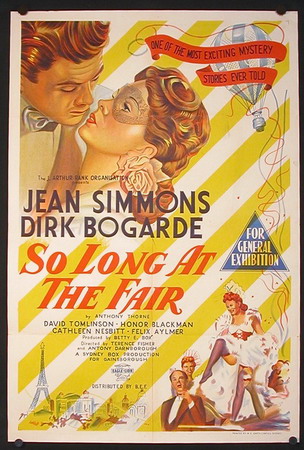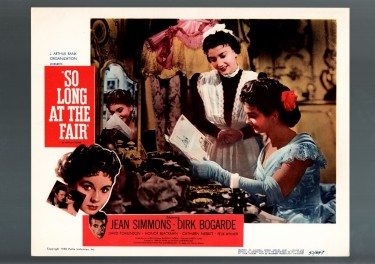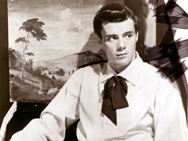I remember watching this with my daughter Joanna, a number of years ago and neither of us knew the storyline at all, so we were completely baffled by the way things developed and we could not work out how and what the conclusion would be. It seemed very sinister but everything fell into place at the end. Great film though and a terrific story.
I really like this film and love the story !!!

It took two directors, Antony Darnborough and Terence Fisher, to create SO LONG AT THE FAIR in 1950. This romantic mystery starred Jean Simmons, Dirk Bogarde, Honor Blackman, and David Tomlinson. Jean Simmons looked stunning as a visitor to Paris searching for her missing brother. It really was a mystery because he had just simply disappeared and no-one in the hotel seemed to remember that he had ever been there.


So Long At The Fair – The Story. – Dont worry we don’t give away the ending !!!
Vicky Barton (Jean Simmons) and her brother Johnny (David Tomlinson) arrive in Paris to attend the Great Exhibition of 1889 and enjoy a night on the town before returning to separate rooms at their hotel. The following morning Vicky discovers her brother is missing. Not only is there no record of his registration at the front desk but his room doesn’t exist either. No one on the hotel staff recalls ever seeing him and in desperation Vicky goes to both the British consul and the local police chief but neither one believes her story. Determined to unravel the mystery of her brother’s disappearance, Vicky enlists the help of a sympathetic stranger, British artist George Hathaway (Dirk Bogarde), and their valiant efforts eventually uncover the truth. Based on a novel by Anthony Thorne, So Long at the Fair (1950) has a premise that bears similarities with Alfred Hitchcock’s The Lady Vanishes (1938) but also looks forward to the “missing person” plot devices of Bunny Lake Is Missing (1965), Flightplan (2005) and other suspense films. Though leisurely paced, the intriguing narrative holds one’s interest through the unexpected but plausible resolution and the authentic period detail, lavish art direction and impeccable performances by the main principals help suspend disbelief. The directorial duties were shared by Antony Darnborough and Terence Fisher who displayed who would eventually attain cult status for his stylish period horror films for Hammer Studios such as Horror of Dracula [1958], The Mummy [1959] and The Curse of the Werewolf [1961]. Both Jean Simmons and Dirk Bogarde were rising young stars in the British film industry when they appeared in So Long at the Fair. Bogarde, who was in danger of being typecast as a hoodlum after his two previous films (Boys in Brown [1949], The Blue Lamp [1950]), remarked in an interview at the time: “…personally, I’m a little tired of spivs wide boys and junior crooks, however they come and in whatever period. I found So Long at the Fair a refreshing change after all these excursions into the shady nooks of petty crooks. For once I wasn’t sharp and sly, or imbued with the reckless daring which springs from cowardice.”

Bogarde and Simmons had never appeared in a film together before (and never would again) but they enjoyed a close working relationship on So Long at the Fair. Bogarde recalled, ‘Jean is about the sweetest girl you could wish to meet and all you read about her being natural and unsophisticated is absolutely true. She has a great sense of fun, and one of these days I would like to do a comedy with her.’ Simmons was equally complimentary saying, “He was such fun – a great giggler. I loved Dirk, and was hoping that perhaps we would be married one day; but I was dreaming, I was fantasising…I never really knew him. I didn’t realise he was gay – in those days people didn’t talk about it.” In another interview, Bogarde confessed that he actually didn’t care for So Long at the Fair, adding “but I had to do it, and at that point, I was very much in love with Jean Simmons. Rank thought it was a great idea to encourage their two juvenile stars and we were given this film which was supposed to launch our engagement. Unfortunately, by the time the film was finished Jean had fallen in love with Stewart Granger, thereby ruining the publicity effort.” Regardless of Bogarde’s own opinion of So Long at the Fair, however, it did help advance his career. One of the film’s producers, Betty E. Box, was so impressed with Bogarde’s performance that she thought of him for the lead in Doctor in the House (1954), the romantic comedy that catapulted him to major stardom in England and led to numerous sequels, two of which also starred Bogarde (Doctor at Sea [1955], Doctor at Large [1957]).
The critical notices for So Long at the Fair were generally positive, with many noting that the incident that sets the plot in motion was inspired by a reputedly famous disappearance case which had taken on the mythic proportions of an urban myth. The New York Times also commented that directors Darnborough and Fisher “have chosen to have their cast speak quite a bit of dialogue in French, a circumstance which may confuse American audiences. But they have also taken the trouble to set that cast, charmingly attired in Victorian bustles and top hats, in authentically bustling, carefree Parisian locales.”
Producer: Betty E. Box, Sydney Box, Vivian Cox Director: Antony Darnborough, Terence Fisher Screenplay: Hugh Mills, Anthony Thorne Cinematography: Reginald Wyer Film Editing: Gordon Hales Art Direction: Cedric Dawe Music: Benjamin Frankel Cast: Jean Simmons (Vicky Barton), Dirk Bogarde (George Hathaway), David Tomlinson (Johnny Barton), Marcel Poncin (Narcisse), Cathleen Nesbitt (Madame Herve), Honor Blackman (Rhoda O’Donovan). BW-86m.




Place your comment